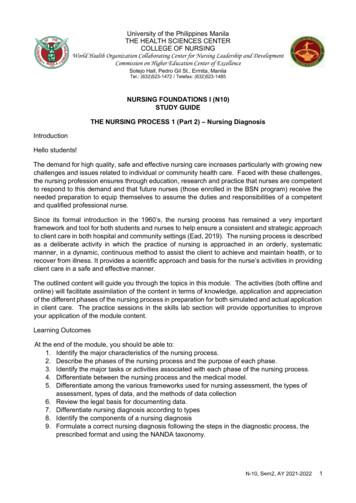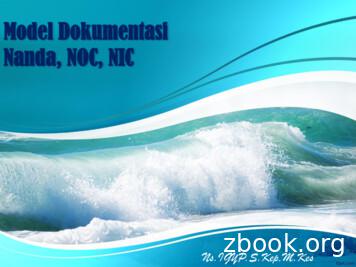Approved NANDA Nursing Diagnosis List 2018-2020
https://health-conditions.comIn the latest edition of NANDA nursing diagnosis list (2018-2020), NANDA International has made some changesto its approved nursing diagnoses compared to the previous edition of NANDA nursing diagnoses 2015-2017 (10thedition). In this latest edition (11th edition), NANDA-I introduced seventeen new nursing diagnoses, and removedeight nursing diagnoses. likewise, seventy-two nursing diagnoses have been revised.Read Also: NANDA nursing diagnoses 2015-2017Read Also: Nursing diagnoses Accepted for used and research 2012-2014Please note that NANDA-I doesn't advise on using NANDA Nursing Diagnosis labels without taking the nursingdiagnosis in holistic approach. NANDA-I explained this in their website as follow:There is no real use for simply providing a list of terms – to do so defeats the purpose of a standardized language.Unless the definition, defining characteristics, related and / or risk factors are known, the label itself ismeaningless. Therefore, we do not believe it is in the interest of patient safety to produce simple lists of terms thatcould be misunderstood or used inappropriately in a clinical context.Definition of a Nursing DiagnosisA nursing diagnosis is defined by NANDA International (2013) as a clinical judgment concerning a humanresponse to health conditions/life processes, or vulnerability for that response, by an individual, family, group, orcommunity.New NANDA Nursing DiagnosesIn this edition of NANDA nursing diagnosis list (2018-2020), seventeen new nursing diagnoses were approved andintroduced. These new approved nursing diagnoses are: Readiness for enhanced health literacyIneffective adolescent eating dynamicsIneffective child eating dynamicsIneffective infant eating dynamicsRisk for metabolic imbalance syndromeImbalanced energy fieldRisk for unstable blood pressureRisk for complicated immigration transitionNeonatal abstinence syndromeAcute substance withdrawal syndromeRisk for acute substance withdrawal syndromeRisk for surgical site infectionRisk for dry mouthRisk for venous thromboembolismRisk for female genital mutilationRisk for occupational injuryRisk for ineffective thermoregulationRetired NANDA Nursing DiagnosesIn this latest edition of NANDA nursing diagnosis list (2018-2020), eight nursing diagnoses were removed fromcompared to the old nursing diagnosis list (2015-2017). These nursing diagnoses are : Risk for disproportionate growthNoncompliance (Nursing Care Plan)Readiness for enhanced fluid balanceReadiness for enhanced urinary eliminationRisk for impaired cardiovascular functionRisk for ineffective gastrointestinal perfusionRisk for ineffective renal perfusionRisk for imbalanced body temperatureApproved NANDA Nursing Diagnosis List 2018-2020
NANDA Nursing Diagnosis Domain 1. Health promotionClass 1. Health awarenessDecreased diversional activity engagement (Nursing Care Plan)Readiness for enhanced health literacySedentary lifestyle (Nursing care Plan)Class 2. Health managementFrail elderly syndrome (Nursing care Plan)Risk for frail elderly syndromeDeficient community healthRisk-prone health behaviourIneffective health maintenance (Nursing care Plan)Ineffective health managementReadiness for enhanced health managementIneffective family health managementIneffective protectionNANDA Nursing Diagnosis Domain 2. NutritionClass 1. IngestionImbalanced nutrition: less than body requirements (Nursing care Plan)Readiness for enhanced nutritionInsufficient breast milk productionIneffective breastfeeding (Nursing care Plan)Interrupted breastfeeding (Nursing care Plan)Readiness for enhanced breastfeedingIneffective adolescent eating dynamicsIneffective child eating dynamicsIneffective infant feeding dynamicsIneffective infant feeding pattern (Nursing care Plan)ObesityOverweightRisk for overweightImpaired swallowing (Nursing care Plan)Class 2. DigestionThis class does not currently contain any diagnosesClass 3. AbsorptionThis class does not currently contain any diagnosesClass 4. MetabolismRisk for unstable blood glucose level (Nursing care Plan)Neonatal hyperbilirubinemiaRisk for neonatal hyperbilirubinemiaRisk for impaired liver functionRisk for metabolic imbalance syndromeClass 5. HydrationRisk for electrolyte imbalanceRisk for imbalanced fluid volumeDeficient fluid volume (Nursing care Plan)Risk for deficient fluid volumeExcess fluid volume (Nursing care Plan)NANDA Nursing Diagnosis Domain 3. Elimination and exchangeClass 1. Urinary functionImpaired urinary eliminationFunctional urinary incontinenceOverflow urinary incontinenceReflex urinary incontinenceStress urinary incontinenceUrge urinary incontinence
Risk for urge urinary incontinenceUrinary retentionClass 2. Gastrointestinal functionConstipation (Nursing care Plan)Risk for constipationPerceived constipationChronic functional constipationRisk for chronic functional constipationDiarrhoeaDysfunctional gastrointestinal motilityRisk for dysfunctional gastrointestinal motilityBowel incontinenceClass 3. Integumentary functionThis class does not currently contain any diagnosesClass 4. Respiratory functionImpaired gas exchangeNANDA Nursing Diagnosis Domain 4. Activity/restClass 1. Sleep/restInsomniaSleep deprivationReadiness for enhanced sleepDisturbed sleep patternClass 2. Activity/exerciseRisk for disuse syndromeImpaired bed mobilityImpaired physical mobilityImpaired wheelchair mobilityImpaired sittingImpaired standingImpaired transfer abilityImpaired walkingClass 3. Energy balanceImbalanced energy fieldFatigueWanderingClass 4. Cardiovascular/pulmonary responsesActivity intoleranceRisk for activity intoleranceIneffective breathing patternDecreased cardiac outputRisk for decreased cardiac outputImpaired spontaneous ventilationRisk for unstable blood pressureRisk for decreased cardiac tissue perfusionRisk for ineffective cerebral tissue perfusionIneffective peripheral tissue perfusionRisk for ineffective peripheral tissue perfusionDysfunctional ventilatory weaning responseClass 5. Self-careImpaired home maintenanceBathing self-care deficitDressing self-care deficitFeeding self-care deficitToileting self-care deficitReadiness for enhanced self-careSelf-neglect
NANDA Nursing Diagnosis Domain 5. Perception/cognitionClass 1. AttentionUnilateral neglectClass 2. OrientationThis class does not currently contain any diagnosesClass 3. Sensation/perceptionThis class does not currently contain any diagnosesClass 4. CognitionAcute confusionRisk for acute confusionChronic confusionLabile emotional controlIneffective impulse controlDeficient knowledgeReadiness for enhanced knowledgeImpaired memoryClass 5. CommunicationReadiness for enhanced communicationImpaired verbal communicationNANDA Nursing Diagnosis Domain 6. Self-perceptionClass 1. Self-conceptHopelessnessReadiness for enhanced hopeRisk for compromised human dignityDisturbed personal identityRisk for disturbed personal identityReadiness for enhanced self-conceptClass 2. Self-esteemChronic low self-esteemRisk for chronic low self-esteemSituational low self-esteemRisk for situational low self-esteemClass 3. Body imageDisturbed body imageNANDA Nursing Diagnosis Domain 7. Role relationshipClass 1. Caregiving rolesCaregiver role strainRisk for caregiver role strainImpaired parentingRisk for impaired parentingReadiness for enhanced parentingClass 2. Family relationshipsRisk for impaired attachmentDysfunctional family processesInterrupted family processesReadiness for enhanced family processesClass 3. Role performance
Ineffective relationshipRisk for ineffective relationshipReadiness for enhanced relationshipParental role conflictIneffective role performanceImpaired social interactionNANDA Nursing Diagnosis Domain 8. SexualityClass 1. Sexual identityThis class does not currently contain any diagnosesClass 2. Sexual functionSexual dysfunctionIneffective sexuality patternClass 3. ReproductionIneffective childbearing processRisk for ineffective childbearing processReadiness for enhanced childbearing processRisk for disturbed maternal-fetal dyadNANDA Nursing Diagnosis Domain 9. Coping/stress toleranceClass 1. Post-trauma responsesRisk for complicated immigration transitionPost-trauma syndromeRisk for post-trauma syndromeRape-trauma syndromeRelocation stress syndromeRisk for relocation stress syndromeClass 2. Coping responsesIneffective activity planningRisk for ineffective activity planningAnxiety (Nursing Care Plan)Defensive copingIneffective copingReadiness for enhanced copingIneffective community copingReadiness for enhanced community copingCompromised family copingDisabled family copingReadiness for enhanced family copingDeath anxietyIneffective denialFearGrievingComplicated grievingRisk for complicated grievingImpaired mood regulationPowerlessnessRisk for powerlessnessReadiness for enhanced powerImpaired resilienceRisk for impaired resilienceReadiness for enhanced resilienceChronic sorrowStress overloadClass 3. Neurobehavioral stressAcute substance withdrawal syndromeRisk for acute substance withdrawal syndromeAutonomic dysreflexiaRisk for autonomic dysreflexiaDecreased intracranial adaptive capacityNeonatal abstinence syndrome
Disorganized infant behaviourRisk for disorganized infant behaviourReadiness for enhanced organized infant behaviorNANDA Nursing Diagnosis Domain 10. Life principlesClass 1. ValuesThis class does not currently contain any diagnosesClass 2. BeliefsReadiness for enhanced spiritual well-beingClass 3. Value/belief/action congruenceReadiness for enhanced decision-makingDecisional conflictImpaired emancipated decision-makingRisk for impaired emancipated decision-makingReadiness for enhanced emancipated decision-makingMoral distressImpaired religiosityRisk for impaired religiosityReadiness for enhanced religiositySpiritual distressRisk for spiritual distressNANDA Nursing Diagnosis Domain 11. Safety/protectionClass 1. InfectionRisk for infectionRisk for surgical site infectionClass 2. Physical injuryIneffective airway clearanceRisk for aspirationRisk for bleeding (Nursing Care plan)Impaired dentitionRisk for dry eyeRisk for dry mouthRisk for fallsRisk for corneal injuryRisk for injuryRisk for urinary tract injuryRisk for perioperative positioning injuryRisk for thermal injuryImpaired oral mucous membrane integrityRisk for impaired oral mucous membrane integrityRisk for peripheral neurovascular dysfunctionRisk for physical traumaRisk for vascular traumaRisk for pressure ulcerRisk for shockImpaired skin integrity (Nursing Care Plan)Risk for impaired skin integrityRisk for sudden infant deathRisk for suffocationDelayed surgical recoveryRisk for delayed surgical recoveryImpaired tissue integrityRisk for impaired tissue integrityRisk for venous thromboembolismClass 3. ViolenceRisk for female genital mutilationRisk for other-directed violenceRisk for self-directed violenceSelf-mutilation
Risk for self-mutilationRisk for suicideClass 4. Environmental hazardsContaminationRisk for contaminationRisk for occupational injuryRisk for poisoningClass 5. Defensive processesRisk for adverse reaction to iodinated contrast mediaRisk for allergy reactionLatex allergy reactionRisk for latex allergy reactionClass 6. ThermoregulationHyperthermiaHypothermiaRisk for hypothermiaRisk for perioperative hypothermiaIneffective thermoregulationRisk for ineffective thermoregulationNANDA Nursing Diagnosis Domain 12. ComfortClass 1. Physical comfortImpaired comfortReadiness for enhanced comfortNauseaAcute painChronic painChronic pain syndromeLabor painClass 2. Environmental comfortImpaired comfortReadiness for enhanced comfortClass 3. Social comfortImpaired comfortReadiness for enhanced comfortRisk for lonelinessSocial isolationNANDA Nursing Diagnosis Domain 13. Growth/developmentClass 1. GrowthThis class does not currently contain any diagnosesClass 2. DevelopmentRisk for delayed development
A nursing diagnosis is defined by NANDA International (2013) as a clinical judgment concerning a human . Risk for disturbed maternal-fetal dyad NANDA Nursing Diagnosis Domain 9. Coping/stress tolerance Class 1. Post-trauma responses Risk for complicated immigration transition
Definition and purpose of nursing diagnosis (NANDA-I) North American Nursing Diagnosis Association Taxonomy (NANDA -I) organizing principles. The purpose of the NANDA International organization is to define, refine, and promote a taxonomy of nursing diagnostic terminology (Herdman, Kamitsuru, & North American Nursing Diagnosis Association, 2018).
with NANDA International were identifi ed, and nurs-ing diagnoses were determined using the diagnostic algorithm of NANDA. In the current nursing diagno-ses, defi ning characteristics and related factors were identifi ed based on the nursing diagnosis of NANDA International 2009-2011. In the case of possible nursing diagnoses, risk fac-
North American Nursing Diagnosis Association (NANDA) NANDA didirikan sebagai badan formal untuk meningkatkan, mengkaji kembali dengan mengesahkan daftar terbaru dari diagnosis keperawatan yang digunakan oleh perawat praktisi. NANDA mengidentifikasi masalah atau k
NANDA-APPROVED NURSING DIAGNOSES 2018-2020 Grand Total: 244 Diagnoses August 2017 Indicates new diagnosis for 2018-2020--17 total Indicates revised diagnosis for 2018-2020--72 total
However, the nursing diagnosis DTPs is of special clinical relevance in the context of mental health care, since it has been proved to be one of the most frequently used nursing diagnosis within this field (Escalada Hernández, Muñoz Hermoso, & Marro Larrañaga, 2013). The exclusion of this nursing diagnosis from the NANDA-I taxonomy makes
NANDA NURSING DIAGNOSIS Last updated August 2009, * new diagnosis 2009-2011. Activity/Rest-ability to engage in necessary/desired activities of life (work and leisure) and to obtain adequate sleep/rest . *Maternal/fetal dyad, risk disturbed .
NANDA (nursing diagnoses), NIC (interventions), and NOC (outcomes). NANDA has 167 diagnosis labels with definitions, defining characteristics, and related or risk factors used to define a client need or problem. NIC is a comprehensive standardized language providing 514 direct and indirect interven-
The FLIR TG267 and TG297 are Automotive Diagnostic Thermal Cameras which combine non-contact temperature measurement and thermal imaging into one troubleshooting tool to help you quickly find the source of heat-re- lated problems and spot potential faults when performing automotive mainte-nance and repair. The FLIR TG267 adds Type-K thermocouple contact temperature measurements. The FLIR TG297 .























